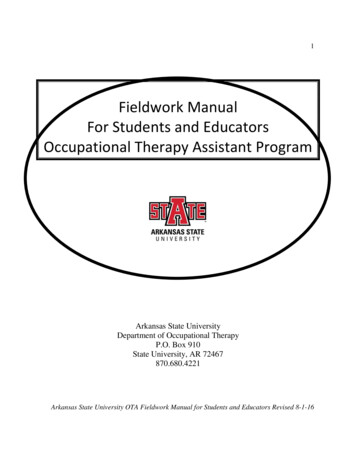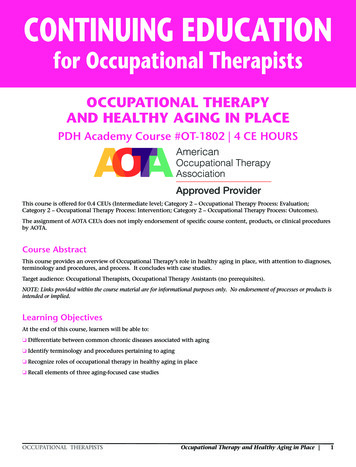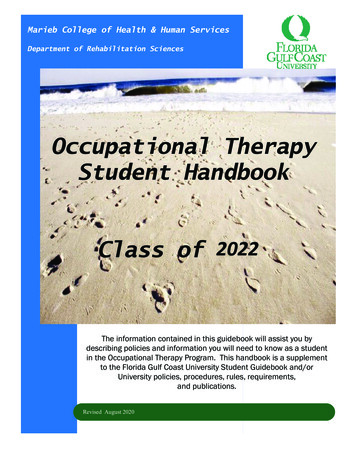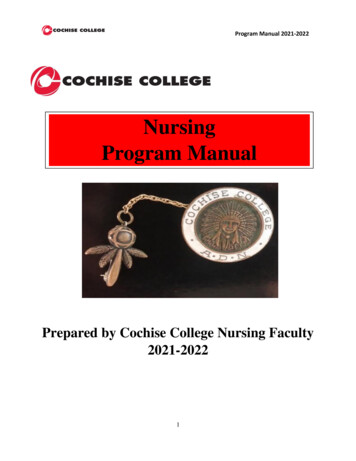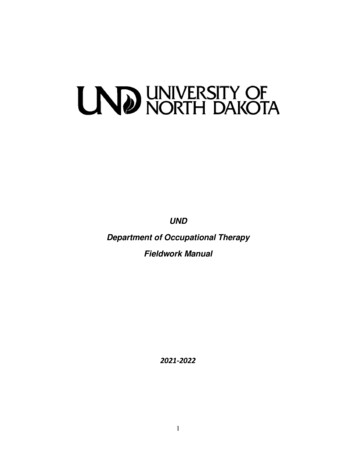
Transcription
UNDDepartment of Occupational TherapyFieldwork Manual2021-20221
Manual for Occupational TherapyFieldwork EducatorsUniversity of North DakotaThis manual is designed to provide fieldwork educators with easily accessible information aboutthe academic and fieldwork portions of the occupational therapy program at the University ofNorth Dakota, with campuses in Grand Forks, North Dakota and Casper, Wyoming.Fieldwork is intended to complement academic preparation by offering additional opportunitiesfor growth, to apply knowledge, develop and test clinical skills and validate abilities thatcomprise professional competence. The academic setting emphasizes the acquisition ofknowledge and affective growth of the student. The fieldwork site provides opportunity topractice and apply knowledge through supervised intervention and professional role modeling.The goal of level II fieldwork is to develop competent, entry-level, generalist occupationaltherapists. Level II fieldwork is integral to the program’s curriculum design and providesstudents with an in-depth experience in delivering occupational therapy services to clients,focusing on the application of evidence-based and meaningful occupation. Fieldworkexperiences are designed to promote clinical reasoning and reflective practice and to transmit thevalues and beliefs that enable ethical practice and the development of professional competence.The fieldwork program is possible through the cooperative efforts of the UND OccupationalTherapy Program, fieldwork partners, and participating students. Information relevant to eachparty regarding policies, procedures, and general guidelines pertaining to both level I and level IIfieldwork education can be found in this manual.The occupational therapy faculty at the University of North Dakota would like to expressappreciation to our fieldwork partners for their continuing contribution to the education of futureoccupational therapists.Cherie Graves, Ph.D., OTR/LAcademic Fieldwork CoordinatorAndrea Young, OTD, OTR/LAcademic Fieldwork CoordinatorHailee ViekmanFieldwork AssistantJanet Jedlicka, Ph.D., OTR/LOccupational Therapy Program Director2
Table of ContentsLetter of Introduction2UND Academic Program Information4Program Description5Curriculum Design Statement11Overview of Course Sequence12Curriculum Design Figure15Curriculum Outcomes16Curriculum Sequence18Course Descriptions20ACOTE Standards for Fieldwork Education24UND Level I Fieldwork DescriptionSemester 128Semester 235Semester 4/541UND Level II FieldworkSemester 649Semester 750Resources for Fieldwork EducationUND Guide for Writing Site-specific Level II Fieldwork Objectives52Template for Writing Level II Objectives56Fieldwork Responsibilities: College, Facility, and Student62UND Policies for Fieldwork ExperiencesGeneral Policies66Level I Fieldwork Policies and Procedures69Level II Fieldwork Policies and Procedures71Evaluation of Fieldwork Sites78Fieldwork Curriculum Assessment FormAppendices79823
Department of Occupational TherapyFaculty: Jedlicka (Chair), Carrlson, Dornbier, Grabanski, Graves, Harris, Haskins,Hulteng, Iseminger, Janssen, Lamborn, Lauer, Loscheider, Meyer, Nielsen, YoungACCREDITATION AND CERTIFICATIONOnly students who have successfully matriculated through an accredited entry-level program inoccupational therapy are eligible to sit for the certification exam.Statement of AccreditationThe Occupational Therapy Program has been granted Pre-Approval Accreditation status forentry-level Occupational Therapy Doctorate by the Accreditation Council for OccupationalTherapy Education (ACOTE). The program will complete the on-site accreditation visit inOctober 2021. For information regarding accreditation, contact ACOTE at (301) 652-2682, orACOTE, 4720 Montgomery Lane, Suite 200, Bethesda, Maryland, 20814-3449. The webaddress is www.acoteonline.org. All basic professional programs must comply with theStandards for an Accredited Educational Program for the Occupational Therapist, 2018.CertificationGraduates of the program will be able to sit for the national entry-level certification examinationfor the occupational therapist administered by the National Board for Certification inOccupational Therapy, INC. (NBCOT, 800 South Frederick Avenue, Suite 200, Gaithersburg,MD 20877-4150; (phone 301-990-7979). After successful completion of this examination thegraduate will be an Occupational Therapist Registered (OTR). Most states require licensure topractice; state licenses may be based on the results of the NBCOT certification examination.It is important to be aware that a felony conviction may affect a graduate’s ability to sit for theNational Board for Certification in Occupational Therapy (NBCOT) certification examination orto attain state licensure as an Occupational Therapist. You will be asked to respond to thefollowing questions when registering for the NBCOT exam: Have you ever been charged with or convicted of a felony?Have you ever had any professional license, registration, or certification revoked,suspended or subject to probationary conditions by a regulatory authority or certificationboard?Have you ever been found by any court, administrative, or disciplinary proceeding tohave committed negligence, malpractice, recklessness, or willful or intentionalmisconduct, which resulted in harm to another?Information regarding NBCOT’s process of screening applicants for Character Review may befound at: www.nbcot.org. If you have any questions, the department will assist you in thisprocess.4
OCCUPATIONAL THERAPY DOCTORATE DEGREE PROGRAMThe Department of Occupational Therapy at the University of North Dakota offers an eightsemester entry level Occupational Therapy Doctorate (OTD) degree. We think you will agreewith us that occupational therapy is a rewarding career choice because of the opportunity itaffords to make a positive difference in people’s lives. Helping people of any age learn torecover from life’s challenges and relearn the skills for the “job of living” is profoundly unique.MISSION STATEMENTThe Department of Occupational Therapy shares the mission of the University of North Dakotaand the School of Medicine and Health Sciences to serve the public through: 1) teaching andpreparation of highly skilled entry-level occupational therapists, 2) scholarly and creativeactivity, and 3) service. The mission is accomplished through integration of scholarly inquiry andapplication of occupation in teaching/learning and OT practice contexts. Best practices in theprofession will reflect the exemplars of client-centeredness, occupation-centered, evidencebased, and culturally relevant practice. The skills for lifelong learning and ethical and effectiveleadership will be promoted to enhance the quality of life of all people with whom we engage.VISION STATEMENTTo prepare occupational therapists who engage in occupation-based, evidence-based, andculturally relevant practice supporting client-centered participation in meaningful occupation thatpromotes health and well-being.OCCUPATIONAL THERAPY AS A PROFESSIONOccupational therapy is a comprehensive health care profession, requiring a diverse set of skillsand abilities that are utilized in varying degrees within OT careers. This variety within practicelends itself to the employment of individuals with many different interests and abilities.Occupational therapists, as a professional group, have a deep commitment to providingcompetent and ethical interventions in collaboration with clients who have many differentoccupational challenges due to health status, state of well-being, and development.The Department of Occupational Therapy is dedicated to the education of students as generalistpractitioners and has received candidacy status from the Accreditation Council for OccupationalTherapy Education (ACOTE). Students are prepared for an occupational therapy career in allareas of practice, equipped with the skills needed to succeed in fieldwork experiences and ineventual clinical practice. After the successful completion of academic preparation, andfieldwork experiences, passing a national certification exam is required prior to practicing as anoccupational therapist.5
Philosophy of the Occupational Therapy ProgramBeliefs About Occupation, Occupational Therapy, and HumanityOccupational therapy helps people of all ages engage in day-to-day activities through therapeuticuse of occupations (AOTA, 2014). The word occupation refers to all of the activities that occupythe individual’s time, meet personal needs, enable participation in family and community life,and sustain health and well-being (AOTA, 2017; Wilcock, 2006). Occupational therapistsbelieve that humans need occupation to grow and thrive; as humans participate in occupation, theunion of the mind, body, and spirit is expressed. Occupations are embedded in the everyday lifeof each person and are best understood in the context of the environment(s) in which they occur(Hooper & Wood, 2014). Occupational therapists believe that occupations and especiallyoccupational participation have the power to impact humans’ state of personal health. Restrictedopportunity for participation in personally valued occupations is believed to result in states ofdysfunction, dissatisfaction, and an overall diminished well-being (Hasselkus, 2011).Occupational therapists believe in occupational justice – the right to access occupationalparticipation and meet basic occupational needs regardless of life circumstances and/or disability(Wilcock & Townsend, 2014).The primary goal of occupational therapy is to promote engagement and participation inpersonally valued occupations to improve health and well-being. To meet this goal,contemporary occupational therapy practice is characterized by four principles: 1) client-centeredpractice; 2) occupation-based practice; 3) evidence-based practice; and 4) culturally relevantpractice (Boyt Schell, Scaffa, Gillen & Cohen, 2014).Client-centered practice reflects the occupational therapist’s desire to understand the uniquenessof each individual and developing a profile descriptive of the individual’s occupations. Theclient-centered therapist fosters development of a therapeutic relationship where theresponsibility for decision-making, including goals and objectives of therapy, is shared with theindividual (Law, 1998). The client is recognized as either a person, group, or population (AOTA,2014).At the core of client-centered practice is occupation. Occupation-based practice is firmlycentered on the individual’s desire for satisfactory occupational performance. The occupationaltherapist seeks to address the personally valued occupations of the individual in contexts mostclosely approximating the natural environment(s) of the individual (Boyt Schell, et al., 2014).Evidence-based practice involves incorporating research evidence into the professionalreasoning process to develop rationales supporting occupational therapy evaluation andintervention practices. The therapist evaluates relevant research, synthesizes the evidence tosupport intervention, and communicates the predicted outcomes to the individual who isencouraged to be a part of the decision-making in therapy (Law & MacDermid, 2008).Culturally relevant practice recognizes that occupations are shaped by culture and that effectiveoccupational therapy must attend to the social, political, and cultural milieu of the individualserved (WFOT, 2010). Occupational therapists are challenged to reflect upon the assumptions6
embedded in their own culture in order to remain open to new understandings present in othercultures.We believe the therapist whose practice reflects client-centered, occupation-based, evidencebased, and culturally competent objectives is able to facilitate engagement and participation inoccupations to meet personal and societal needs.Beliefs About Teaching and LearningReflecting our beliefs about the value of occupation to human beings, our philosophy of teachingand learning begins with the core subject of occupation. Subject-centered learning enableseducators and their students to keep the profession’s core subject at the center of learning(Hooper et al., 2014; Palmer, 1998). We believe maintaining occupation as our central focus isfundamental to students’ development of sound professional reasoning and ultimately,professional identity (Bilics, 2014; Hooper et al., 2014).Keeping occupation at the center, experiential learning philosophy guides our conceptualizationof the learner, the educator, and methods utilized to facilitate learning. We believe that learningoccurs when practical experiences are paired with methods that facilitate connection betweenthese experiences and understanding occupation (Hooper et al, 2014; Merriam, Caffarella, &Baumgartner, 2007a). As students come to understand occupation, we intentionally provideopportunities for critical reflection in order to prepare students for self-authorship (Brookfield1987; Fink, 2003; Hooper, 2010; Merriam et al., 2007b). Therefore, we complement ourexperiential learning philosophy with transformational learning methods. The outcome isstudents are capable of self-authorship where they can use their internalized understanding ofoccupation and their identity as an occupational therapist to solve novel problems and aspire tobecome agents of change in the profession (Hooper, 2010). With this in mind, we set forth ourview of the learner, educator, context, and process of learning.View of the LearnerLearners will come with previous experiences which are used to connect to new learning aboutthe occupational therapy profession (Merriam et al., 2007a; Hooper et al., 2014). Learners aremotivated by the perceived necessity to learn the information (Merriam et al., 2007a). Learnersare invested in their learning. With this motivation comes the ability to initiate and engage inself-directed inquiry. The learner takes responsibility for being an active participant—able totransfer knowledge and skills into both the professional and personal arenas of his or her life(Sell, 2008). The learner is curious and tolerates ambiguity as they engage in the learningprocess. The learner collaborates with others in an array of dynamic learning strategies asimplored by environmental and situational demands (Merriam, et al., 2007a, 2007b).Learning ProcessWe believe learning how to reason like an occupational therapist is critical to the learningprocess. Initially, learning requires an individual to have some underlying foundational concepts(Fink, 2003; Sell, 2008), with attention being given to the learner being self-directed in acquiringfoundational knowledge. Foundational concepts include an understanding and knowing of theprofession’s core, human occupation, in which all additional concepts and knowledge should besituated within (Hooper, et al., 2014). Once the learner has an understanding of the conceptual7
foundation, the next stage in the progression of learning is “learning how to think like an OT”,where emphasis is given to mastering critical thinking within the domain of occupationaltherapy. Rather than an emphasis on content alone, learning involves mastering more complexways of knowing through critical thinking processes (Boyt-Schell & Schell, 2008; Schon, 1987).To facilitate the process of learning, it is believed that learning occurs when learners areprovided opportunities to readily engage with knowledge through application, evaluation, andsynthesis. The final stage is the ability to synthesize learning or engage in self-authorship (Fink,2003; Hooper, 2010). The ultimate outcome is when the learner has acquired the skills andattitude to be a life-long learner and change agent.View of the EducatorEducators establish a classroom culture that facilitates development of the inquisitive nature ofthe student to further enable them to ask the critical questions of themselves, of the occupationaltherapy profession and of the society in the future (Merriam et al., 2007a; Hooper et al., 2014).This includes understanding current practice, posing missing elements, and developing solutionsfor future practice (Hooper, 2010). The educator fosters positive relationships between thecommunity of learners (student, educator, practitioner, researchers, and consumers). Educatorscarefully construct learning experiences from a repertoire of contextualized instructionalmethods based on where students are in the learning process (Merriam et al., 2007a, 2007b).ContextThe context of learning should encompass a variety of learning activities to address both theneeds of the learner and the learning outcomes. The best learning opportunities are those thatprovide authentic experiences to promote active engagement in higher order thinking andproblem solving to prepare students for self-authorship (Boyt-Schell & Schell, 2008; Hooper2010; Merriam et al., 2007a). Students are likely to learn more when they learn in collaborationwith a community of learners (Boyt-Schell & Schell, 2008). Collaborative learning enhancescooperation, discourse, teamwork, and heightens the individual’s learning through self-reflection(Boyt-Schell & Schell, 2008). The community of learners takes equal responsibility to create apositive climate for learning. Assessment and feedback are fostered through a supportiveenvironment and enable understanding of what learners bring to the classroom and aid inadjusting the context to promote effective learning (Angelo & Cross, 1993).ReferencesAmerican Occupational Therapy Association (2014). Occupational therapy practice framework:Domain and process (3rd ed.). American Journal of Occupational Therapy, 68(Supplement I), S1-S48.American Occupational Therapy Association Commission on Education (2017). Philosophicalbase of occupational therapy. American Journal of Occupational Therapy, 71(Suppl.2),7112410045. https://doi.org/10.5014/ajot.2017.716S06Angelo, T. A., & Cross, K. P. (1993). Classroom assessment techniques: A handbook for collegeteachers (2nd ed.). San Francisco: Jossey-Bass.8
Bilics, A. (2014). Philosophy of occupational therapy education. AOTA: Commission onEducation.Boyt Schell, B. A., & Schell, J. W. (2008). Clinical and professional reasoning in occupationaltherapy. Baltimore, MD: Lippincott & Williams & Wilkins.Boyt Schell, B. A., & Scaffa, M. E. Gillen, G., & Cohen, E .S. (2014). Contemporaryoccupational therapy practice. In Boyt Schell, B. A., Gillen, G., Scaffa, M. E. & Cohen,E. S. (Eds), Willard and Spackman’s Occupational Therapy (pp. 47-58). Baltimore, MD:Lippincott, Williams & Wilkins.Brookfield, S. D. (1987). Developing critical thinkers: Challenging adults to explore alternativeways of thinking and acting. San Francisco, CA: Jossey-Bass.Fink, L. D. (2003). Creating significant learning experiences. San Francisco: Jossey-Bass.Hasselkus, B. R. (2011). The meaning of everyday occupation. Thorofare, NJ: SLACK, Inc.Hooper, B. (2010). On arriving at the destination of the centennial vision: Navigationallandmarks to guide occupational therapy education. Occupational Therapy in HealthCare, 24(1), 97-106.Hooper, B., Krishnagiri, S., Price, M. P., Bilics, A. R., Taff, S. D., & Mitcham, M. (2014). Valueand challenges of research on health professions’ core subjects in education. Journal ofAllied Health, 43(4), 187-193.Hooper, B., & Wood, W. (2014). The philosophy of occupational therapy: A framework forpractice. In Boyt Schell, B.A., Gillen, G., Scaffa, M.E., & Cohen, E.S. (Eds). Willardand Spackman’s Occupational Therapy (pp.35-46). Baltimore, MD: Lippincott,Williams & Wilkins.Law, M. (Ed.). (1998). Client-centered occupational therapy. Thorofare, NJ: SLACK, Inc.Law, M. & MacDermid, J. (2008). Evidenced-based rehabilitation. Thorofare, NJ: SLACK,Inc.Merriam, S. B., Caffarella, R. S., & Baumgartner, L. M. (2007a). Experience and learning (pp.159-186). Learning in adulthood. San Francisco, CA: Jossey-Bass.Merriam, S. B., Caffarella, R. S., & Baumgartner, L. M. (2007b). Transformational learning (pp.130-158). Learning in adulthood. San Francisco, CA: Jossey-Bass.Palmer, P. J. (1998). The courage to teach: Exploring the inner landscape of a teacher’s life.San Francisco: Jossey-Bass.Schön, D. A. (1987). Educating the reflective practitioner. San Francisco: Jossey-Bass.9
Sell, R. G. (2008). Meeting the needs of adult learners. In R.M Diamond (Ed). Designing andassessing courses and curricula: A practical guide. (pp. 257-270). San Francisco, CA:John Wiley & Sons.Wilcock, A. A. (2006). An occupational perspective of health. Thorofare, NJ: SLACK, Inc.Wilcock, A. A., & Townsend, E. A. (2014). Occupational Justice. In Boyt Schell, B. A., Gillen,G., Scaffa, M. E. & Cohen, E. S. (Eds), Willard and Spackman’s Occupational Therapy(pp. 541-552). Baltimore, MD: Lippincott, Williams & Wilkins.World Federation of Occupational Therapists (2009). Position statement on diversity andculture. Retrieved from http://www.wfot.org10
UND OTD Curriculum Design StatementOccupation is the center of our curriculum (See Figure 1 Curriculum Design). This fulfills ourvision, mission and philosophy to develop therapists who promote engagement and participationin personally valued occupations to improve health and well-being for a diverse society.Occupation at the core is fundamental to the development of sound professional reasoning andprofessional identity (Bilics, 2014; Hooper et al., 2014). Consequently, four curriculum threadsare connected to occupation and are integrated throughout courses in the program: 1) Art andScience of Occupational Therapy); 2) Professional Identity and Collaboration, 3) Innovative andIntentional Leadership, and 4) Diversity and Inclusive Participation. These four threads organizeour curriculum outcomes (see Table 1) and reflect those concepts inherent to understanding ourprofession (Giddens, Caputi, & Rodgers, 2015).Integral to the context of learning is the community of learners, learning strategies, and learningprocess. Community of learners have equal responsibility in creating a positive and supportivelearning environment. Context is particularly important in experiential and transformationalphilosophies where student engagement in authentic experiences is critical to the learningprocess. Consistent with our beliefs, learning occurs through dynamic and interactive strategies.These strategies function to connect threads to occupation throughout the curriculum. Facultyand fieldwork educators are experts at utilizing contextualized learning strategies. Our studentsequally contribute by building on previous experience through critical reflection, activelyengaging in self-directed inquiry and collaborative learning.The learning process occurs in three stages and is critical to how we sequence our curriculum(See Figure 1). During the first stage, students engage in understanding foundational conceptsinherent to the profession and reflected in each of our curricular threads. Emphasis is placed onunderstanding occupation, occupational therapy, cultural competence, and leadership. Oncestudents have the foundational concepts, they enter the second stage where facilitation of criticalthinking about occupation begins. For example, students will apply reasoning in theoccupational therapy process, use research for best practice, apply occupational therapy modelsduring intervention, utilize management principles, and begin work on justice and policy. Duringstage three, students are able to synthesize learning and engage in the highest level of learningwhere students utilize critical thinking for innovative practice and are capable of initiating actionsteps to becoming agents of change.Semester 1: Stage 1: Foundational ConceptsSemester 2: Transition from Stage 1: Foundational Concepts to Stage 2: Critical ThinkingSemester 3: Stage 2: Critical thinkingSemester 4: Stage 2: Critical thinkingSemester 5: Stage 2: Critical thinkingSemester 6: Stage 2: Critical thinking (Level IIA)Semester 7: Transition from Stage 2: Critical thinking to Stage 3: Synthesis (Level IIB)Semester 8: Stage 3: Synthesis (Experiential)11
Overview of Course Sequence:Semester 1 encompasses Stage 1: Foundational Concepts where students are learning those skillsfoundational to occupational therapy practice regardless of practice context. OT 400 Culture andOccupation emphasizes understanding culture and its influence on occupational performance.OT 401 OT Process and Practice Contexts provides students with an understanding of the OTprocess, strategies for professional reasoning, and an understanding of practice contexts. OT402 Research Foundations in OT students understand qualitative and quantitative researchmethodology as used in the occupational therapy profession and applies principles of evidencedbased practice investigation, critiques and the process of presentation and publication of researchprojects. OT 404 Occupation and Analysis emphasizes understanding the occupational nature ofhumans, theories of practice and analysis of occupation. OT 405 Forming Your ProfessionalIdentity addresses the history of OT, values and ethics, and the distinct value of occupationaltherapy along with the beginning of professional development. Lastly, OT 406 Integration andFieldwork emphasizes safety in occupational therapy practice and provides hands-onopportunities in level I fieldwork to apply concepts learned across courses in the semester.Semester 2 involves the transition from Stage 1: Foundational Concepts to Stage 2: CriticalThinking. During this semester, the primary emphasis is placed on critically thinking aboutoccupation by applying foundational concepts as students begin to engage in the OT process withthe primary emphasis being evaluation. Specifically, in OT 403 Research Methods inOccupational Therapy, students design qualitative and quantitative methodology and engage inanalysis. In addition, students learn to apply evidence to practical clinical scenarios and developfurther their identity as occupational therapy clinician-researchers. In OT 439 Health and DiseaseAffecting Occupational Performance, students understand normal development and disruptionsof occupational performance by analyzing impacts on occupational performance. Concurrently,students are enrolled in OT 440 Evaluation of Occupational Performance where they begin toanalyze occupational performance in the evaluation process across the lifespan and acrosspractice contexts. OT 442 Integration and Fieldwork 2 provides opportunity to bring togetherconcepts across courses in problem-based cases, hands-on learning in level I fieldwork andthrough exposure to consumers. OT 442 Leadership Foundations in OT students applyleadership theories and models, understand OT leaders, and analyze their own leadership skills inregard to professional development in preparation for Level II Fieldwork and the DoctoralExperiential Placement.During semester 3, students are engaged in Stage 2: Critical Thinking as they continue tocritically think about occupational performance. In OT 443 Movement and OccupationalPerformance, students study human anatomy and kinesiology in order to gain competence in theevaluation of and intervention planning for the occupational performance of human beings.Included are human body dissection, theory and techniques of musculoskeletal evaluation withanalysis of normal and pathological human motion. The emphasis of this semester is completingthe evaluation process and beginning to engage in intervention; thus students are enrolled in OT444 Introduction to OT Intervention where students are applying intervention approaches andtypes, health literacy concepts, client/teaching/learning process approaches, and group processwith opportunities to function as a group facilitator.12
The student continues in Stage 2: Critical Thinking, as the focus of study transitions fromevaluation to the intervention component of the OT process in semester 4. In OT 500Interventions for Mental Functions Applied to Occupational Performance, students useevaluation data to plan interventions, intervention planning, implementation, review, andoutcomes with specific emphasis for populations across the lifespan where occupationalperformance is affected by mental functions. In OT 501 Interventions for Neuro-musculoskeletaland Movement Functions Applied to Occupational Performance, students utilize critical thinkingskills necessary to understand interventions across the lifespan for neuro-musculoskeletal andmovement functions specific to occupational performance. In OT 502 Management andAdvocacy for Occupational Therapy Practice, students will understand the role of theoccupational therapy manager and be able to analyze public policy and apply leadership skillsthrough advocacy efforts. OT 503 Integration and Fieldwork 3 is an opportunity for synthesis ofcontent covered in this semester and students apply learning through integrated case studies,consumers, and level I fieldwork. In OT 510 Experiential 1, students will review expectations ofthe Doctoral Experiential Placement and process, IS/SP culminating project guidelines, samplesof potential sites, procedures for contacting sites, and the Background/Purpose section of theDoctoral Experiential Memorandum of Understanding. Additionally, half of the students areenrolled in OT 469 Inter-professional Health Care course.During Semester 5 students continue in Stage 2: Critical Thinking when they plan intervention inOT 512 Interventions for Sensory Functions Applied to Occupational Performance and OT 513Community-based Practice Interventions. Concurrently, students are enrolled in OT 514Innovative Practitioner where they critically think as they engage in needs assessment andprogram planning which brings together evaluation and intervention planning for populations oragencies. OT 516 Integration and Fieldwork 4 continues to provide an opportunity forintegration of concepts learned across the semester as stude
Manual for Occupational Therapy Fieldwork Educators University of North Dakota This manual is designed to provide fieldwork educators with easily accessible information about the academic and fieldwork portions of the occupational therapy program at the University of North Dakota, with campuses in Grand Forks, North Dakota and Casper, Wyoming.


